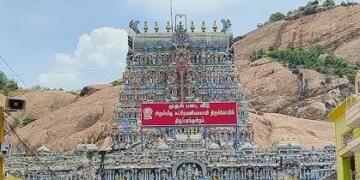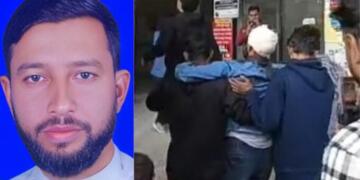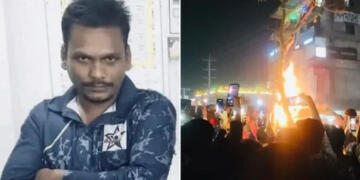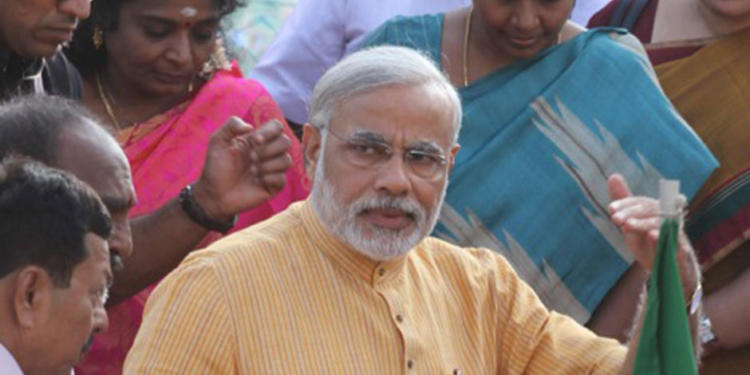A notion, deliberately created by some individuals, who call themselves as intellectuals, has been persistent in the country since independence. It is nothing but the divide between the north and south of India. This not only yields vote banks, but also adds fuel to the “Break India movement”.
The Bharatiya Janata Party, when formed in 1980, was victimized in the country for being able to obtain the people’s trust in the Northern part of India more than the Southern region. Bharat Ratna Atal Bihari Vajpayee, when addressing the Lok Sabha in 1996 during the trust vote, had mentioned this on record, as how BJP has been stereotyped as a party coming from the ‘Cow Belt’.
But as days have passed on, we need to look at how people have started accepting the so-called Cow Belt party in the south. Under the leadership of Prime Minister Narendra Modi, BJP fought the 2014 elections which was an exclamatory start of a changed perception within the voters’ minds. The Prime Minister, many times on the floor of the Lower House, has reiterated the fact that the MP from Ladakh (The northernmost tip), the MP from Kanyakumari (the southernmost tip), the MP from Kutch (the westernmost tip) and the MP from Arunachal Pradesh (the easternmost tip), all belong to the BJP.
India is at the brim of General Elections 2019, and each party is busy campaigning and asking for votes, be it the virtually claimed Mahagathbandhan of all the opposition parties, or the BJP-led NDA. Media reports of NDA allies threatening to quit the alliance in Uttar Pradesh, Meghalaya, Maharashtra, Assam and more had also been doing rounds on social media.
But, NDA got a boost when BJP’s old alliance partner in Maharashtra, the Shiv Sena agreed with the BJP on its seat share logic for the upcoming Lok Sabha elections. The major boost was when the Bharatiya Janata Party represented by Union Minister Piyush Goyal sealed a pact with the AIADMK (All India Anna Dravida Munnetra Kazhagam) and the PMK (Pattali Makkal Katchi) on the 19th of February, 2019 in Tamil Nadu. This sends a clear message, that even parties differing with the BJP on various fronts have recognized the commendable work that Prime Minister Modi has done for the nation.
But, there is a need of a binocular analysis on how things have twisted and turned since the first time Late Selvi J. Jayalalithaa led AIADMK had joined hands with Atal Bihari Vajpayee-led BJP. Here is the point by point analysis of BJP’s debut in Tamil Politics or Hindutva’s debut in Tamil politics:
In 1998, the Congress Party withdrew support from IK Gujral’s government. The BJP entered into an alliance with the Jayalalithaa led AIADMK only to see the alliance secure 31 out of 39 seats in Tamil Nadu. The hard fact to be noted is that the state government, at that point of time, was ruled by DMK under the Chief Ministership of Late Thiru M. Karunanidhi. But, as times changed, AIADMK MPs staged a walkout from the Lok Sabha regularly demanding the Income Tax cases against Jayalalithaa be withdrawn by the Central Government, and also, dismiss the DMK-led Government in the state which was alleged to have a nexus with the Pakistan based ISI. The famous trust vote of 1998 in the history of Indian politics saw Jayalalithaa withdrawing the support from the Central government, when Atal Bihari Vajpayee’s government had to collapse with the lack of just 1 vote.
This withdrawal of support by AIADMK hadn’t gone down well with many of the BJP leaders who had expressed anguish against the allegedly treacherous politics of Jayalalithaa. Later, in 1999, Atal Bihari Vajpayee trusted aid Late Pramod Mahajan, went into talks with the DMK and joined hands only to separate before the 2004 elections after the successful tenure completion by a non-Congress government at the centre.
This was the beginning of BJP’s relationship with Tamil Nadu, where later, Jayalalithaa claimed to have introduced Atal Bihari Vajpayee to the Dravidian heartland.
But, today, it’s the Modi era. It’s the Prime Minister’s leadership which holds supreme diplomacy even on international fronts as a national representative as well as in the NDA while stitching alliances with other parties.
As the Chief Minister of Gujarat, Narendra Modi was believed to have a very good friendship with Tamil Nadu Chief Minister Jayalalithaa. Also, when Narendra Modi was nominated as the BJP’s Prime Ministerial candidate for the 2014 elections, Jayalalithaa expressed her admiration towards the able leadership of Narendra Modi. She reportedly went on to say that she considers Modi as an able administrator, and if he receives any elevation in his party or in the administration, she is happy for him.
Basically, this was the point where people, and especially media, started speculating about chances of an AIADMK-BJP alliance before the 2014 elections which didn’t happen. There were many issues which were raised by Jayalalithaa in front of Modi, where many have claimed to have received a very fruitful cooperation from the Central Government. In various events where Sushma Swaraj, the External Affairs Minister took the Sri Lankan fishermen issue with her Sri Lankan counterparts on many fronts and vowed for a joint committee to trace the issue, Jayalalithaa was reported to have expressed happiness with the prompt response.
Demonetization received Jayalalithaa’s patting
After the Prime Minister’s boldest move on 8th November, 2016 – Demonetization, all opposition parties irrespective of their political ideologies joined hands to criticize the move of the government. Lok Sabha also witnessed various disruptions amidst the on-going procedure of Demonetization to get rid of black money. In such a case, AIADMK and Jayalalithaa’s silence was invariably questioned by the media. AIADMK took to state the party’s stand as, “Demonetization is a good decision, but the problems faced by people should be looked into”.
Also, in 2017, AIADMK Rajya Sabha MP V. Maitreyan called Demonetization as a Surgical Strike within the borders, expressing his views in the Economic Times. Such a support from the party in presence of Jayalalithaa was itself a clear indication of a soft corner towards the NDA government at the center.
In December 2016, when the country lost Jayalalithaa, the Prime Minister immediately visited Chennai the next day to pay tributes to the Late Chief Minister.
But, as she left a void, many political analysts raised questions on the future of Tamil politics. With Rajanikanth and Kamal Hassan announcing their new respective political parties, the Tamil political diaspora grew more as a mess rather than a straight expected mandate from the people.
With AIADMK breaking into 3 factions, one of Sasikala and TTV Dhinakaran, other two of O. Panneerselvam and the current Chief Minister Thiru E. Palaniswami respectively, the void became more apparent.
But, it was Narendra Modi who played a major role in uniting the two factions, one of O. Panneersevam, usually known as OPS and E. Palaniswami, usually known as EPS. This could be taken as just a political move, but today, one can clearly observe the consequences of that move. M.K. Stalin, the son of Fmr. DMK Chief Late M. Karunanidhi, sniffed the political plot behind this and came down heavily on the Prime Minister for having played a “Kangaroo court” in uniting the two factions of AIADMK. The negotiating table, at that point of time has brought a lot of observations into the Tamil Nadu politics, which made the very less known leader Thiru E. Palaniswami, the Chief Minister and Thiru O. Panneerselvam, the Deputy Chief Minister of Tamil Nadu. Many political analysts expected the leadership of EPS to be an upcoming failure as the AIADMK MLAs may rebel against many of his decisions due to his poor hold over the party. But, in the past 2 years of his government, he has been able to hold all the nodes together for his government to have its say on the floor of the house.
Not only this, AIADMK supported the government on various issues, including one of the most important ones, the Goods and Services Tax. AIADMK hailed the GST as one of the biggest tax reforms.
Not only that, people also started a postulation of actor-turned-politician Rajinikanth getting into the NDA. Rajinikanth, on various fronts frankly supported the Prime Minister issuing statements in public. He had also expressed faith in the NDA, in comparison to the Mahagathbandhan of the opposition parties.
But, there were dry moments for the relationship between the two parties as on many occasions, leaders including the Chief Minister of Tamil Nadu expressed anguish over the behaviour of BJP.
The bitter twist was when media saw the other side of Tamil politics too, that is a possible DMK-BJP alliance. As I mentioned above, DMK had allied with Atal ji’s government. So, it was easier for the BJP to go with the DMK rather than AIADMK based on its past experiences. Prime Minister also visited ailing DMK chief Karunanidhi and it was noted by media sources that the house call was planned hours before he met the Dravidian politician.
Also, the chief minister of Tamil Nadu went on to say that AIADMK is not a puppet of the BJP and it will oppose what should be opposed. This statement of the CM came just after several top BJP leaders including Union Minister Nitin Gadkari attended a DMK party event in the state.
The second senior most leader of the Lower House, Deputy Speaker Thiru Thambidurai slammed the Central Government on many situations. Thambidurai expressed discontentment with the government at the centre on the issue of setting up a Cauvery Management Board. With M.K. Stalin calling the Tamil Nadu government as a “puppet” of the Center, Thambidurai rose to the occasion putting the opposition and the center in a tough situation by announcing that he is ready to move a no-confidence motion against Modi government in case the Congress party promises in written to consider the state’s issues.
Ironically, after the no-confidence motion was moved, AIADMK MPs voted against the no-confidence motion, that is, in support of the Modi government, which the government easily won. This sent a clear message to Tamil Nadu and the Southern political diaspora that, the rise of Modi and BJP in the south is evident and is set to pull the ground off the oppositions’ feet.
This was not the only instance when the senior AIADMK leader took on Modi and BJP, he also went on to say in Trichy that BJP is trying to saffronize Tamil Nadu and that he won’t let the party keep it’s foot in the land of Annadurai, MGR, Ramasamy Naicker and Jayalalithaa. Thambidurai, after the famous and pro-public interim budget of 2019, said that it is less an interim budget, and more like an election manifesto of the BJP for the upcoming Lok Sabha elections.
In the last winter session of the 16th Lok Sabha, Speaker Sumitra Mahajan had to suspend 24 AIADMK MPs initially, and 19 MPs later for causing continued disruptions in the proceedings of the house. The MPs were protesting against a dam on the Cauvery River. This was seen as a very important issue in the southern state as the Modi government gave a go-ahead to the dam, and it was a direct attack on the Central government.
Apart from all these experienced and old parties making and breaking their relationships with each other, the main focus was on Superstar Rajinikanth and Tamil actor Kamal Hassan. Their introduction to politics raised a major question on how will Tamil Nadu vote and what will be the issues that shall be addressed.
But, in the meantime, Rajinikant broke the news saying that he won’t contest the Lok Sabha elections. This may have 2 different reasons behind it. The first being, that he wants to grow the base of his political party, and the second being that he wants to pave way for the BJP to register its growth on the front foot in the state. The speculation of the second reason is justified as, if he had allied with the NDA, then the alliance with AIADMK would not have been possible, because AIADMK being an old party would have asked for a larger seat share and the seat sharing formula would have been illogical at any instance for any party. Now, if the MGR- founded party couldn’t ally, then there were all chances of the vote share of NDA being cut to a very large extent in the polling.
After all these events, the most interesting part remains in the happy-ending
As soon as the BJP and the AIADMK finalized a pre-poll pact, Thambidurai changed his statements from “Center not providing enough funds to Tamil Nadu” to “Now the state can get more funds”.
E Palaniswami was one of the few non-BJP leaders who accredited the air strikes conducted by the Indian Air Force to the Prime Minister. The masterstroke came when Deputy Chief Minister O. Pannerselvam, sharing the stage with the PM, went on to say that Narendra Modi has taken the ‘Narsimha avatar’. The Prime Minister visited Kanyakumari to gift Tamil Nadu with various projects such as Rs. 2995 crore highways and Amma’s dream scooter scheme. He also appreciated the Tamil Nadu government for its developmental works and remembered Amma in his speech many times.
This change of words and history of events are clearly inclining to a growth of the support for the BJP and the Prime Minister’s policies in the past 5 years. With acceptance growing in the political diaspora rapidly, we need to do simple mathematics to evaluate the possible acceptance among the Tamil population.
With many media channels claiming a clean sweep for the UPA before the poll pact between AIADMK and BJP, this is a situation of severe reconsideration for their opinion polls. Just by summing up the vote share of the NDA and AIADMK in 2014, it sums up to approximately 60% against the UPA alliance between Congress and DMK which sums up to 35%. Considering the drawbacks of Amma not being the one to lead the elections anymore in the state, we also need to see that the popular leader against Amma, M. Karunanidhi is also no more to lead the election campaign for the DMK. So, both fronts are set to lose something and the other in the elections as per the current trends suggest. Yet, we cannot ignore the fact that the BJP has made remarkable gains in the southern state which shall add to the NDA’s vote share, and rather give a big blow to the opposition.
With the Prime Minister giving many assurances and fulfilling his promises to the people of the state with his charismatic leadership at the Centre, it is clear that the 2019 elections are in favour of Narendra Modi’s second term.
The Hindi imposition and other vote bank issues may start doing rounds on some social media handles as well as the opposition parties now onwards will start raising these ‘issues’. Moreover, the need to move towards a developmental agenda is more important in coordination with the regional aspirations than raising the so called issues mentioned above.
Regionalism is a boon when it is done to preserve the cultural heritage of a region but when it is hyped, it is nothing, but politics. This time, the 2019 elections seem to be set to deliver an all-round verdict in support of the Prime Minister.

































